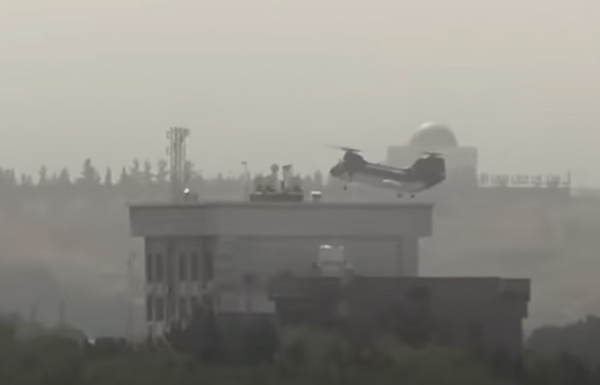The government spent BILLIONS to equip Afghan forces, only for American military hardware to end up in Taliban hands
08/18/2021 / By Arsenio Toledo

All of the military equipment the United States gave to Afghanistan to build up its military capabilities ultimately ended up in the hands of the Taliban.
The U.S. spent nearly $89 billion in two decades to train and equip the Afghan National Army, its police and its other affiliated security forces. When these armed elements collapsed – in some cases without even firing a single shot at the Taliban – in the wake of the Taliban’s 2021 offensive, they left behind a lot of U.S.-acquired hardware.
This means this offensive, which culminated in the fall of the Afghan capital of Kabul to the Taliban, did not just win the Islamic fundamentalist group land and political power. It also gave it a lot of American military hardware. (Related: Former U.S. military commander of all Afghanistan forces says Biden regime’s withdrawal is ‘catastrophic for the U.S.’ as he predicts new wave of terrorism.)
This includes not just an untold number of guns and ammunition, but also military vehicles like Humvees. Reports show that the Taliban even acquired multiple U.S. and Soviet-made helicopters and at least one attack aircraft that America purchased from a Brazilian manufacturer. It is unclear whether the Taliban have the personnel or the expertise to pilot the helicopters and airplanes.
One defense official that spoke with the Associated Press on condition of anonymity confirmed that the Taliban acquired an enormous amount of formerly Afghan equipment supplied by the U.S.
Large cache of US weapons taken by Taliban in this compound. #Afghanistan pic.twitter.com/F4UYVphh3Q
— FJ (@Natsecjeff) August 13, 2021
Doug Lute, a retired Army lieutenant general who helped direct strategy in Afghanistan during the administrations of former presidents George W. Bush and Barack Obama made it clear that what the Afghans lacked was not material resources.
“The principle of war stands – moral factors dominate material factors,” said Lute. “Morale, discipline, leadership, unit cohesion are more decisive than numbers of forces and equipment.”
Military analysts agree with this assessment. Speaking to mainstream media outlet NPR, military analyst Jason Dempsey explained that the U.S. had never overcome the “fundamental challenge” of the effort to strengthen Afghan security forces. He said the U.S. was trying to build “an Afghan National Army for a nation that simply doesn’t exist.” This, in turn, “kind of contributed to the speed with which everything collapsed.”
“Given that the U.S. war strategy depended on the Afghan army’s performance, however, the Pentagon paid surprisingly little attention to the question of whether Afghans were willing to die for their governWithment,” said journalist Craig Whitlock.
“Money can’t buy will. You cannot purchase leadership,” said John Kirby, chief spokesman for Secretary of Defense Lloyd Austin.
#BREAKING
Taliban have seized A-29 Super Tucano light attack aircraft and MD-530F light military helicopter at the Mazer-i-Sharif airport. pic.twitter.com/CI3oXe8d8Y— WorldOnAlert (@worldonalert) August 15, 2021
The US spent nearly $2.3 trillion on Afghanistan over 20 years
Compared to the rest of what the U.S. spent in Afghanistan over two decades, the $87 billion it shelled out from taxpayers to build up Afghan security forces looks like just another drop in the bucket. From 2001 to April 2021, the War in Afghanistan cost American taxpayers around $2.262 trillion. This is according to estimates made by the Costs of War Project at Brown University.
This estimated tally includes around $1.376 trillion given to the Department of Defense – $443 billion to increase the department’s base budget for war-related expenses and $933 billion for “overseas contingency operations. The costs also include $59 billion given to the Department of State in additional funding, $296 billion towards providing care for veterans of the War in Afghanistan and around $530 billion that went toward interest payments on debt accumulated due to the war.
Congress also appropriated more than $88.6 billion in taxpayer funding to build up Afghanistan’s security forces. This represents sixty-one percent of all the funding given for Afghanistan’s reconstruction since the fiscal year of 2002, according to the Special Inspector General for Afghanistan Reconstruction (SIGAR).
“The question of whether that money was well spent will ultimately be answered by the outcome of the fighting on the ground, perhaps the purest M&E exercise,” wrote SIGAR in a report published several weeks ago.
Another cost that needs to be looked at is in lives. From the beginning of the war until April of this year, 2,448 U.S. service members lost their lives. Another 3,846 U.S. contractors were killed while in Afghanistan. Furthermore, 1,144 service members from allied nations who followed the U.S. into Afghanistan also lost their lives there. Another 444 aid workers and 72 journalists also died during the 20-year conflict.
Another estimated 233,000 people lost their lives during the 20-year conflict. This includes casualties incurred by the Afghan military and police and its allied militia fighters and nearly 50,000 Afghan civilians.
Learn more about how much the government is spending on endless wars by reading the latest articles at GovernmentDebt.news.
Sources include:
Tagged Under: Afghan military, Afghanistan, Collapse, dangerous, defense spending, disaster, failed state, government, government spending, military, national security, taliban, terrorism, War, war in Afghanistan
RECENT NEWS & ARTICLES
COPYRIGHT © 2017 TERRORISM NEWS



















